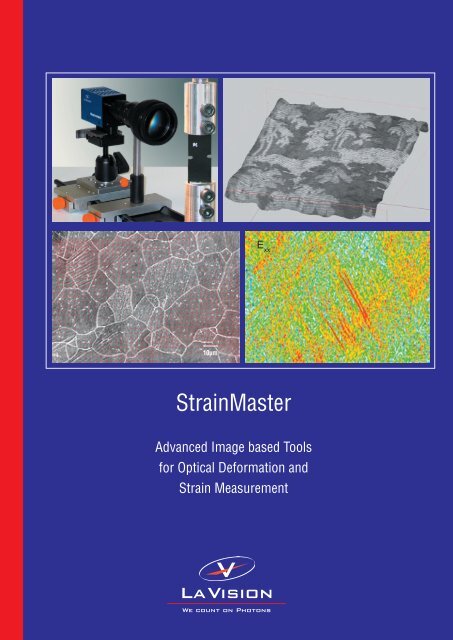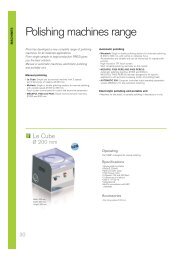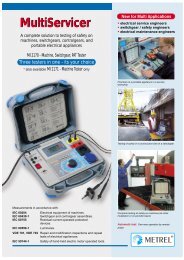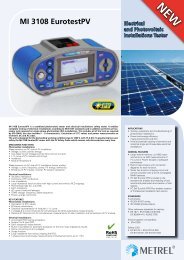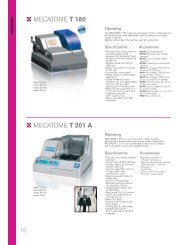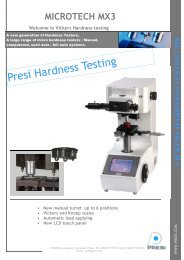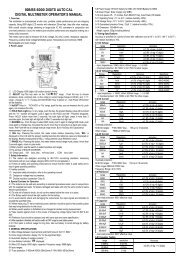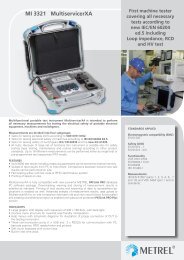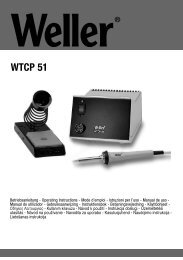StrainMaster
StrainMaster
StrainMaster
Create successful ePaper yourself
Turn your PDF publications into a flip-book with our unique Google optimized e-Paper software.
E xx<br />
10µm<br />
<strong>StrainMaster</strong><br />
Advanced Image based Tools<br />
for Optical Deformation and<br />
Strain Measurement<br />
LaVision<br />
We count on Photons
<strong>StrainMaster</strong><br />
optical deformation and strain<br />
field imaging<br />
LaVision<br />
We <strong>StrainMaster</strong> count from on LaVision Photons is a state-of-the-art, non-intrusive optical tool for<br />
shape, deformation and strain analysis of solid, granular and liquid subjects.<br />
<strong>StrainMaster</strong> combines the most advanced Digital Image Correlation (DIC)<br />
algorithms with the highest quality hardware to provide a complete and easy to<br />
use device for material analysis. <strong>StrainMaster</strong> is applicable across all industries<br />
investigating material behaviour and gives fast and highly accurate results via an<br />
easy to use PC based interface.<br />
applications<br />
<br />
<br />
<br />
<br />
<br />
<br />
<br />
solid components, granular movement or liquid flows<br />
Non-Destructive Testing (NDT)<br />
fracture mechanics<br />
Thermal Mechanical Fatigue (TMF) tests<br />
long term tests or ultra fast deformation analysis<br />
microscopic to large scale experiments<br />
Fluid Structure Interaction (FSI)<br />
<strong>StrainMaster</strong> can be supplied as a complete turn-key system or as stand alone<br />
software for importing and processing images from an external source such as a<br />
Scanning Electron Microscope (SEM). The system offers a complete solution and<br />
data management system able to drive hardware, acquire images, process data,<br />
validate and display or export information.<br />
A range of <strong>StrainMaster</strong> systems are available from portable field work machines<br />
to highly specialized lab versions. Any system can be tailored to suit your<br />
particular requirements, and are appropriate for both industrial and academic<br />
applications across a range of subject areas.<br />
industries<br />
<br />
<br />
<br />
<br />
<br />
<br />
<br />
power generation<br />
biomedical / bioengineering<br />
polymer science<br />
mechanical engineering<br />
aerospace<br />
automotive<br />
geology and environmental<br />
2
<strong>StrainMaster</strong><br />
Digital Image Correlation<br />
LaVision<br />
We The system count uses on Digital Photons Image Correlation with standard single camera or<br />
stereoscopic multi camera setups to record 2D in-plane deformation or 3D<br />
surface measurement. Our system uses highly accurate multi-pass Fast Fourier<br />
Transform algorithms to calculate the displacement of applied surface patterns or<br />
naturally occurring features.<br />
t 1<br />
The user typically acquires a series of images during a material testing<br />
experiment, with the first image normally being the case of zero applied load. The<br />
surface is illuminated by standard or specialized light sources and the<br />
displacement of the surface pattern between successive images is calculated by<br />
advanced grey scale analysis:<br />
t 2<br />
cell<br />
cross correlation peak search<br />
t 1<br />
t 2<br />
rubber bricks under compression<br />
displacement<br />
<br />
<br />
<br />
<br />
Entire image of surface is discretized into smaller cells (interrogation cells).<br />
A correlation field is computed in each cell using Fast Fourier Transformation<br />
(FFT).<br />
The maximum correlation corresponds to the displacement.<br />
The displacement gives the vector length and direction for this window.<br />
advanced<br />
algorithms<br />
<br />
<br />
<br />
<br />
<br />
<strong>StrainMaster</strong> uses several advanced processing algorithms for maximum<br />
accuracy:<br />
multi-pass processing to maximize the retained particle pattern within each<br />
cell even for large displacements<br />
deformed interrogation cells to eliminate correlation peak smearing<br />
Whittaker reconstruction mode for unmatched sub-pixel accuracy<br />
choose cell size and shape (square or non-square interrogation cells)<br />
ability to measure from 0.01 to 1000 pixel deformation<br />
accuracy<br />
When utilizing larger cells, more information is available in the contained pattern<br />
and therefore the measured displacement is more precise. Accuracies down<br />
to 0.01 pixels are possible using larger cells, yielding local strain accuracies of<br />
40µstrain or better. Global accuracy across images using the incorporated strain<br />
gauge feature can be down to 3µstrain with high resolution cameras.<br />
3
computer<br />
and electronic<br />
CCD-camera<br />
<strong>StrainMaster</strong><br />
working principle<br />
force tensor<br />
crack<br />
sample<br />
material testing<br />
machine<br />
LaVision<br />
We After the count suitability on of Photons<br />
the natural or applied pattern has been assessed and any<br />
necessary illumination organized, the measurement and analysis can take place.<br />
Note that the viewed image is easily calibrated using simple geometry information<br />
known about the subject for 2D. The supplied two level calibration plate in<br />
conjunction with our highly accurate calibration algorithms can be used for 3D<br />
cases. The calibration procedure can take place before or after the data<br />
acquisition.<br />
I. Image acquisition or import is controlled via the software. The image<br />
sequence is recorded and stored in a project, or alternatively images<br />
are easily imported.<br />
II. The deformation is calculated using advanced cross correlation<br />
algorithms yielding a grid (matrix) of surface displacement vectors.<br />
Rigid body motion can be removed via shift and rotation correction.<br />
III. Validity of the displacement vectors is assessed using local and global<br />
information about the sample deformation. Additional post-processing<br />
or fi ltering is also possible.<br />
IV. Displacement data is displayed in vector or grid form, and can show<br />
strain derivatives as background contours together with the original<br />
sample image in order to clearly identify maximum strain locations<br />
and fracture mode behaviour.<br />
V. The incorporated virtual strain gauge feature allows the user to place<br />
a gauge anywhere on the sample after the test is complete. This can be<br />
plotted against time, or load data recorded using an integrated analogue<br />
to digital converter<br />
t 1<br />
t 2<br />
composite structure tensile test<br />
deformation grid and strain contours<br />
strain gauge<br />
Tensile test on notched composite specimen -<br />
specimen provided by the University of<br />
Nottingham<br />
4
<strong>StrainMaster</strong><br />
complete solutions<br />
LaVision<br />
We During count image acquisition Photons the powerful <strong>StrainMaster</strong> system is able to command<br />
pulsed lighting, automate translation stage movement, control camera exposure<br />
and frame rate, record analogue load data and synchronize with external (e.g.<br />
cyclic) events.<br />
During post-test calculations, the user is able to set up batch operations for<br />
multiple processing steps, set up a hyperloop processing sequence to do<br />
calculations on multiple image sets, and even utilize the resources of networked<br />
PCs via a distributed processing system. All recorded images and resultant data<br />
are managed within the active <strong>StrainMaster</strong> project.<br />
<br />
<br />
<br />
<br />
<br />
easy set up and analysis<br />
fast data acquisition<br />
complete data management<br />
control and synchronization with external devices<br />
(phase locked measurements)<br />
maximize resource utilization via batch and<br />
distributed processing<br />
<strong>StrainMaster</strong> project<br />
software abilities<br />
The <strong>StrainMaster</strong> software provides a complete data management system. A<br />
project is created for each test, and this contains the data tree of raw images,<br />
calculated data and derivatives. The batch operation mode for image and data<br />
calculation can include user defined functions written in the macro programming<br />
language, providing maximum flexibility. The data structure within the project is<br />
mirrored in windows explorer so the file management is completely transparent.<br />
Storage of images uses a special lossless image compression algorithm to<br />
minimize the required disk space, although export of standard formats is also<br />
simple.<br />
special features<br />
<br />
<br />
<br />
<br />
<br />
<br />
<br />
moving mask to automatically adapt with shifting boundaries<br />
shift and rotation correction to remove rigid body motion<br />
virtual strain gauge (video extensometer) included as standard<br />
3D display for overlay of image on recorded surface height<br />
variety of export file types including multiple window movies<br />
image stitching which can be automated with translation stages for very high<br />
resolution image generation<br />
vector or grid display combined with strain map and raw images<br />
5
<strong>StrainMaster</strong><br />
2D analysis<br />
3D analysis<br />
LaVision<br />
2D We analysis count is appropriate on Photons where surface height<br />
deformation is negligible. The right example<br />
shows a typical tensile test, with the image<br />
sequence indicating the increased strain levels<br />
in the sample. On the front cover the lower left<br />
image shows a sample of stainless steel<br />
under compression including the overlayed<br />
deformation field viewed by SEM. On the<br />
right image the corresponding strain field<br />
Exx is computed showing local shear bands.<br />
Image courtesy : Dr. Joao Quinta da Fonseca MMSC,<br />
Manchester University<br />
The calibration process for 3D<br />
measurements is made easy with the<br />
supplied two level calibration plates. strain development within<br />
a stretched sample<br />
With a 3D (stereoscopic) setup,<br />
analysis of shape, deformation and surface strains is possible. The<br />
advanced display allows original images to be overlaid on the measured<br />
surface height. The example on the top right of the front cover shows the<br />
measured surface (amplified to illustrate changes) of a tapestry material.<br />
Image courtesy : Dr. Janice Barton, Southampton University<br />
granular flows<br />
2D subsurface deformation (2D sectional view with displacement field)<br />
surface flows<br />
height<br />
color<br />
The left image shows an experiment that<br />
simulates the deformation and mass transfer<br />
of tectonic plates. The simulation works with<br />
granular materials like quartz sand or micro<br />
glass. The <strong>StrainMaster</strong> system measures the<br />
motion of the different quartz sand layers and<br />
computes the strain field.<br />
Image courtesy: Jo Lohrmann and Jürgen Adam,<br />
Geo Forschungszentrum Potsdam, Germany<br />
A useful upgrade to the <strong>StrainMaster</strong> system allows the analysis of free surface<br />
flows in terms of their shape, deformation, and velocity changes with time. The<br />
image below shows the visualization of water waves impacting on an obstacle.<br />
This new analysis tool is ideal for coupling the effects of surface shape with<br />
surrounding flow field.<br />
6
<strong>StrainMaster</strong><br />
hardware upgrades<br />
LaVision<br />
We A variety count of hardware on Photons<br />
upgrades and additions are possible to LaVision<br />
<strong>StrainMaster</strong> systems, to suit every customer’s requirements.<br />
Multiple camera control with frame rates up to 1,000,000 fps and resolutions<br />
up to 11Mpix are possible.<br />
<br />
<br />
<br />
<br />
<br />
<br />
A/D converter for measuring simultaneous load cell data<br />
microscope setups for small scale investigations<br />
translation stages for automated data acquisition across a region<br />
PC Raid storage systems for high data volumes<br />
a variety of specialized lenses for the cameras<br />
Image Doubler for combining measurement techniques, e.g. PIV & Strain using<br />
one camera<br />
software upgrades<br />
<br />
<br />
<br />
<br />
PointTracker<br />
To evaluate position, movement and deformation of discrete points on a subject.<br />
Accurate measurement is achieved by tracking and recording distances between<br />
markers on the object.<br />
Particle Image Velocimetry (for Fluid-Structure Interaction studies)<br />
Using laser light sheet illumination to measure the fluid mechanics of a flow<br />
impinging on an object. This could be utilized to analyse the interaction of<br />
airflow on a wind turbine blade and to measure the resultant blade motion.<br />
Optical Crack Tracer (OCT)<br />
Working on a variety of materials, OCT measures and tracks a crack during<br />
initiation and propagation. It calculates the Critical Stress Intensity factor and<br />
Strain Energy Release rate. Optical Crack Tracer is a development of LaVision in<br />
coorporation with Fraunhofer Institute IZM.<br />
Surface Flow, for free surface liquid applications<br />
Studies free surface flows and their interaction with solid surfaces.<br />
<br />
Tomographic software analysis package for full volume<br />
calculations of X-ray or CT scans<br />
Analysis of full volume information of a material, yielding a 3D<br />
volume of 3 component deformation data.<br />
Image courtesy: Dr. Sam McDonald, University of Manchester<br />
7
Specifications<br />
<strong>StrainMaster</strong><br />
Standard<br />
Optional<br />
CCD resolution 1600 x 1200 pixel up to 4000 x 2600 pixel<br />
CCD dynamic 12 bit up to 16 bit<br />
CCD shutter gate 1 µs down to 100 ns<br />
repetition rate 30 frames/ s up to 10 6 frames/ s<br />
accuracy<br />
down to 0,01 Pixel<br />
40 µstrain locally<br />
3 µstrain globally<br />
optics f= 50 mm; 1: 1,8 micro zoom<br />
microscopes<br />
long distance microscopes<br />
telecentric lenses<br />
electronics<br />
computer<br />
A/D converter<br />
12 bit dynamic<br />
8 input channels<br />
250 kHz sampling rate<br />
sync board<br />
Dual Core<br />
MS-Windows<br />
LaVision Software DaVis Crack Growth Analysis<br />
2D / 3D Strain<br />
Crack Statistics<br />
K1c and G1c Package<br />
<strong>StrainMaster</strong><br />
components<br />
options:<br />
computer<br />
software<br />
CCD camera<br />
electronics<br />
A/D converter for external signals<br />
sync board<br />
illumination sources<br />
3D upgrade<br />
wide range of LaVision’s CCD cameras<br />
optics, microscopes<br />
mechanical setup<br />
image stitching (automatic image stitching,<br />
using translation stages is optional)<br />
motorized stages<br />
LaVisionUK Ltd<br />
Downsview House / Grove Technology Park<br />
Grove / Oxon / OX12 9FF / United Kingdom<br />
e-Mail: sales@lavisionuk.com<br />
www.lavisionUK.com<br />
Phone: +44-(0)-870-997-6532<br />
Fax: +44-(0)-870-762-6252<br />
LaVision GmbH<br />
Anna-Vandenhoeck-Ring 19<br />
D-37081 Goettingen / Germany<br />
E-Mail: Info@LaVision.com<br />
www.LaVision.com<br />
Tel.: +49-(0)5 51-9004-0<br />
Fax: +49-(0)551-9004-100<br />
LaVision Inc.<br />
301W. Michigan Ave. / suite 403<br />
Ypsilanti, MI 48197 / USA<br />
e-Mail: sales@lavisioninc.com<br />
www.lavisioninc.com<br />
Phone: (734) 485 - 0913<br />
Fax: (240) 465 - 4306<br />
01/07


